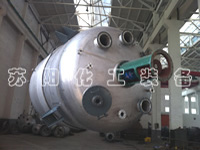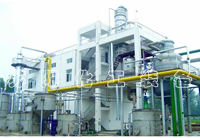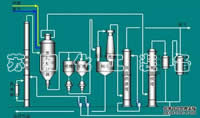Methylal, urotropine complete set of equipment series
-

Tropine Crystallization Kettle -

20,000 Tons per Year Gas-phase Hexamethylenetetramine Plant -

Engineering Cases of Hexamethylenetetramine Complete Plant
Hexamethylenetetramine Complete Equipment Series
Hexamethylenetetramine, also known as urotropine, is a white hygroscopic crystalline powder or colorless, lustrous rhombic crystals. It is combustible. It is prepared by the condensation of formaldehyde and ammonia. The formaldehyde solution is placed in a reactor, and ammonia is introduced. The condensation reaction takes place in an alkaline solution at a reaction temperature maintained between 50-70°C. The feed liquid is cooled and then enters a liquid film vacuum evaporator, where it is evaporated at 60-80°C to increase its concentration from 24% to 38%-42%. Then the reaction liquid is filtered, crystallized by vacuum evaporation, and dried by suction filtration to obtain the finished product of hexamethylenetetramine. It is widely used as a curing agent for resins and plastics, a vulcanization accelerator for rubber (accelerator H), a shrink-proof agent for textiles, and is also used in the production of fungicides, explosives, etc. Medicinally, after oral administration, it decomposes in acidic urine to produce formaldehyde, which has a bactericidal effect and is used for mild urinary tract infections; externally, it is used to treat ringworm, stop sweating, and treat body odor. When mixed with caustic soda and sodium phenolate, it is used as a phosgene absorbent in gas masks. Hexamethylenetetramine is also a commonly used corrosion inhibitor to slow down the corrosion of metal materials.
Currently, there are mainly two production processes for hexamethylenetetramine at home and abroad, namely the liquid-phase method and the gas-phase method. Among them, the liquid-phase method is the preferred process for the next step of treating by-product dilute formaldehyde in paraformaldehyde production plants.



